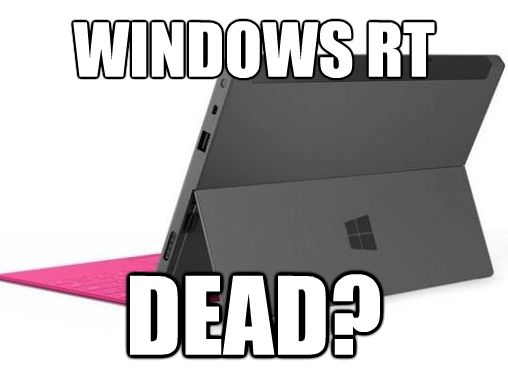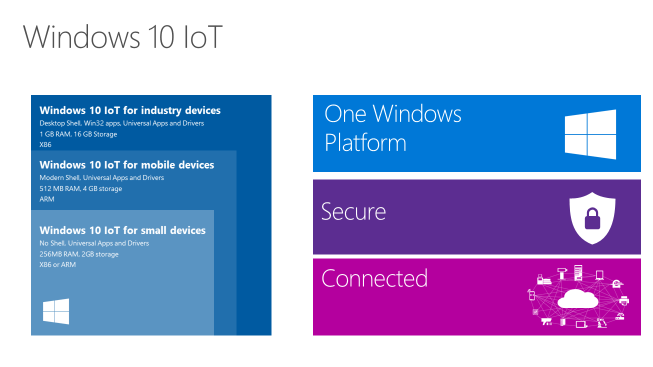Windows RT: Did it really die? Absolutely not and here's why

There's no need to ask for a show of hands. To get a sense of how long the Windows RT hate-train is, you can just spend a few minutes Googling. A few weeks ago when Microsoft let loose that official Windows RT devices, like the Surface 2, were not getting Windows 10 in any proper shape, the anti-RT chorus cheered that they have been finally vindicated.
Stories like this one which adorned The Verge planted their flags pretty clearly: "Windows RT is officially dead".
Admittedly, I've been one of the few lone champions of the intriguing slimmed-down OS this side of the interwebs. I outlined my favorable position on Windows RT in a lengthy op/ed about one year ago, hitting on numerous aspects of why RT (and Windows on ARM, in general) is a fantastic idea that has been sputtering due to execution, not capability.
The false-start that just recently came to fruition, now called Universal Apps (formerly Modern UI apps), is something Windows 8 as a whole could have used during launch season back in 2012.
But even so, we've got customer deployments out in the wild built upon Windows RT-based Surface tablets which replaced x86 laptops, and believe it or not, these clients are still raving about these devices to colleagues. Their extreme portability, full featured access into native Windows RDP, very good peripheral compatibility, and splendid battery life makes them much more desirable than a traditional laptop -- in many, but not all -- cases.
Windows RT: Dead in Name Only
It's well known that sensational news is great news, especially for today's tech media. But while most of them were busy jumping on the "RT is dead" bandwagon, many of them failed to do the proper due diligence to actually figure out what Microsoft really meant when they discussed the end of Windows RT a few weeks back.
So for the sake of setting the record straight for the majority of the copy-paste tech media, here's a breakdown on how they got the news wrong, and what actually is the case for the future of RT.
What The Tech Media Reported
Microsoft Kills Off Windows RT (Geeky Gadgets)
RIP Windows RT: Microsoft murders ARM Surface, Nokia tablets (The Register)
What Microsoft Actually Said
No Windows 10 Update for Surface RT (ZDNet)
Microsoft reiterates support for ARM amid reports of Windows RT’s death (GeekWire)
That's it? That's what all the hubbub was actually about? Sadly, yes. The tech media had a fun time playing with semantics to toss more gas onto the Windows RT firestorm it loved to stoke.
The long and short of what is happening with Windows RT is pretty darn simple:
- Microsoft (Surface and Surface 2) and Nokia (Lumia) branded ARM-based tablets will NOT be getting a formal update to Windows 10. They will be entitled to limited subset upgrades of Windows 10 functionality, but will not be given Windows 10 as we know it.
- Windows RT as its own SKU, or brand, of Windows will be going away (naturally).
- Windows RT's combined direct spiritual successors are the Windows 10 Mobile and Windows 10 IoT SKU lines, which work on devices under 8" in size and DO feature ARM processors.
- Windows 10 Mobile devices will not have access to "desktop" mode, and as such, lack of any proper x86 app support.
Nowhere did Microsoft say that all ARM devices will not be getting Windows 10. Nowhere did Microsoft say that the strides made in the "Modern UI" approach to eradicating the x86 desktop were going away.
In fact, just as recently as the revived WinHEC 2015 conference, Microsoft confirmed that Windows 10 SKUs will be fully supported for gadgets/gidgets as well as phones and small tablets:

(Image Source: AnandTech)
And for those doubtful about Microsoft's commitment to ARM-based devices, one of the cheapest small PCs around, the Raspberry Pi 2, has already been confirmed to be getting full Windows 10 treatment for free, too.
For the uninitiated, the Raspberry Pi 2 is a mini PC featuring a lowly 900MHZ ARM CPU with only 1GB of RAM. For Microsoft to dedicate an official blog post of its own to the news, this whole "ARM thing" must be less of an experiment and more of a long term vision that is just warming up.
On top of Microsoft's Raspberry Pi 2 boasting, some news sites have unveiled mention of benchmarks culled from a graphics testing website which highlight specs of a yet-unknown big screen Windows (10?) tablet that runs on a quad core ARM, supports DirectX 11, and has a 2560 x 1440 display at 10.1".
Is it a prototype Surface 4 ARM device? Or perhaps a new Lumia ARM tablet? Or even another OEM's unnamed tablet? We can't say. But for me, it's hard not to connect the dots and come to some limited conclusions about Windows on ARM keeping pace or picking up with Windows 10.
How Windows RT Gave Windows 10 Mobile Its Mojo
For all the commentary out there claiming that Windows 10 is going to be exactly that which Windows RT wasn't, it's quite interesting in how much common ground the two operating systems share from a structural and UI perspective. In fact, I'm fully convinced that Windows RT's most important guts and aspects are direct inspirations for much of what Windows 10 Mobile/ IoT is shaping up to be.
The commonalities are numerous, with Windows RT and Windows 10 Mobile/IoT sharing all of these overlapping aspects:
- Both have full support for ARM processors.
- Both have zero support for x86 legacy applications.
- Both rely on Modern UI apps (now changing to Universal Apps) from the Windows Store.
- Both offer high levels of native security due to the tight restrictions on Windows Store apps, and a lack of x86 execution.
- Both offer superior battery life due to ARM CPU support.
- Both have very good, and growing, external device compatibility due to the inclusion of native full sized USB connectivity.
- Windows 10 Mobile is a direct result of consolidation of the Windows Phone and Windows RT code bases, creating the common core of "One Windows" that Microsoft is pushing.
So, once again, I have to ask: what's so different about Windows 10 from Windows RT? They are descendants of one very common lineage, separated merely by time and generation. The most innate defining features of what made Windows RT, well, Windows RT, are present and kicking in Windows 10 Mobile and IoT.
Some claim that Microsoft kicking Surface and Surface 2 to the wayside are evidence of no future for larger Windows on ARM devices. But as Paul Thurrott insinuates, and I agree with, there is nothing even short of confirming this is the case.
Per a recent article going into some post-RT commentary, Paul put it plainly:
What if you wish to get a Windows 10 Mobile device with a screen bigger than 7.9 inches? Again, a guess: I think Microsoft will let PC makers sell such a device. I just don’t think they’re going to sell that version of Windows at retail.
Could this lead further credence to an upcoming scene of new large Windows 10 ARM tablets or convertibles? Who knows. It's too early to say, honestly.
The clear takeaway here is without debate: Windows 10 Mobile shares far, far more in common with Windows RT than many in the media wish to admit to.
And that, in my opinion, is a great win for the former RT, even if its namesake is heading to the coffers and it never gained much steam in its own right.
